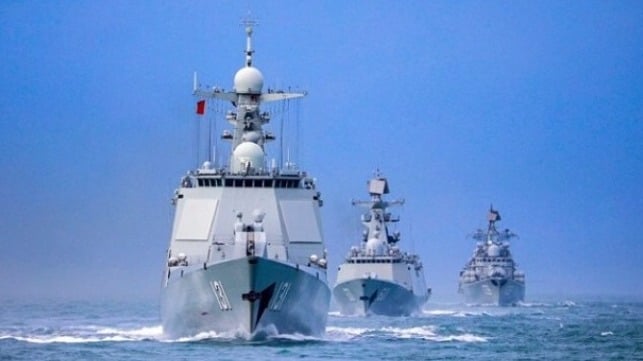Op-Ed: China is Getting Stronger, But Taiwan Invasion in 2025 is Unlikely

[By Joe Keary]
Despite China’s rapid military improvements, it’s unlikely to use large-scale force against Taiwan in 2025. The Chinese leadership’s concerns over the quality of military command, economic weakening, uncertain social stability, and effects of the Trump administration will likely forestall any large-scale military maneuver.
However, China will continue to ramp up pressure against Taiwan in 2025.
On January 6, the United States’ new defense secretary, Pete Hegseth, told the Senate Armed Services Committee he believed a Chinese Communist Party fait accompli invasion of Taiwan was the pacing risk scenario for the Department of Defense. He reminded the committee that "Xi Jinping has openly expressed his intention to annex Taiwan to mainland China" and "has told his military to be prepared to use force to achieve such an outcome by 2027."
Like its successes in artificial intelligence, improvements in China’s military should not be underestimated. In several areas, China’s military is now reaching standards typical of the US military. China’s navy is transforming rapidly and by the end of 2025 is expected to have 395 ships, including three operational aircraft carriers. China is also improving its amphibious fleet, acquiring assault ships that can carry large numbers of landing craft, troops, fixed-wing drones, armored vehicles, and helicopters. In early 2025, there were reports of China building special barges that would support Taiwan landings.
China’s military now has the largest aviation force in the region, with new fighters and stealth aircraft that expand its ability to operate farther from its shores. It is also increasing its inventory of nuclear weapons and now has the world’s leading arsenal of hypersonic missiles. The army has increased the number of troops along the Taiwan Strait and improved its firepower, mobility, and rapid strike capabilities.
Throughout 2024, China’s military and coast guard continued to exercise Taiwan invasion and blockade scenarios. In May, following the inauguration of Taiwanese President Lai Ching-te, Beijing launched large-scale military exercises, surrounding Taiwan within two days. In October, it undertook a second series of drills, taking just one day to implement a mock blockade or quarantine of Taiwan. In December, China staged its largest show of force in decades, showing the world how it could repel a foreign force approaching Taiwan.
The military has dramatically improved its ability to conduct a blockade or invasion, but Beijing will still have doubts. During the release of the 2024 China Military Power Report, senior Pentagon officials said, "despite its rapid progress, the force has not yet demonstrated the type and scale of sophisticated urban warfare or long-distance logistic capabilities that would likely be required for operations against Taiwan." A lack of combat experience is a significant imposition for a force wanting to undertake complicated operations across the Taiwan Strait. Exercising will only get you so far.
Serious questions have also been asked about China’s officer corps and their ability to ‘judge situations, understand higher authorities’ intentions, make operational decisions, deploy troops, and deal with unexpected situations’. Corruption also remains an endemic issue, with China’s military experiencing a new wave of corruption-related scandals over the past two years that has led to the removal of two defense ministers and a high-ranking member of China’s Central Military Commission.
Domestic factors will also influence any decision to use military force. China is facing adverse demographic trends, including an aging population and low birth rates. There are other internal struggles, such as a trend of rising violence, following a string of indiscriminate mass attacks throughout 2024.
China is also seeking to manage a faltering economy, worsened by ballooning local government debt, a loss of investor confidence and the gradual collapse of its real estate sector. Beijing has struggled to stimulate domestic consumption, relying on its growing share of global exports to drive the economy. Researchers at Rhodium Group estimated that China’s GDP was only 2.4 to 2.8 percent higher in 2024 than a year earlier, well below the official claim of 5.0 percent growth.
China’s trade surplus reached a new high of nearly US$1 trillion in 2024. Beijing will be wary of the impact of a potential trade war with the United States. It will want to strengthen its trade relationships with other partners to reinforce its economy. China has already sought to recalibrate ties with Japan, India and Australia, while doubling down on its engagement with the Global South. Within this context, China will want to perform a careful balancing act over Taiwan. It will not want to damage international relationships by taking unnecessarily aggressive military actions.
Amid the problems, the leadership nonetheless probably has growing confidence that, if called upon, the military will be able to ‘resolve the Taiwan issue’. However, Xi probably hasn’t yet decided to use force against Taiwan.
2027 almost certainly remains a short-term goal for military modernization, not a date for a Taiwan invasion. Concerns over the economy and social stability will remain as key priorities for China’s leadership.
Xi will also want to carefully assess the Trump administration’s resolve on the Taiwan issue. Trump has hinted at a more transactional approach to Taiwan, suggesting it contribute more to its own security while still supporting Taipei’s right to self-defense. Trump is already threatening tariffs on Taiwan’s semiconductors.
In 2025, China’s military will continue to undertake exercises around Taiwan as part of a broader coercion campaign against Taipei. However, the likelihood of large-scale use of force against Taiwan in 2025 remains low.
Joe Keary is a senior analyst at ASPI. This article appears courtesy of ASPI's The Strategist, and may be found in its original form here.
The opinions expressed herein are the author's and not necessarily those of The Maritime Executive.
